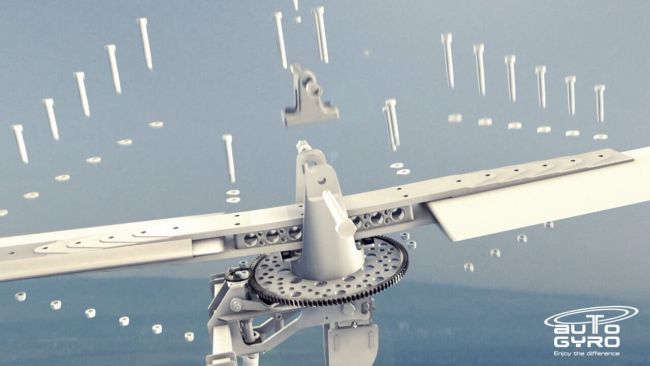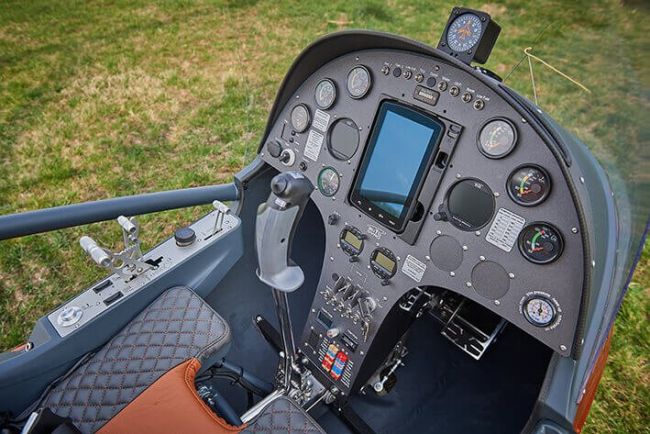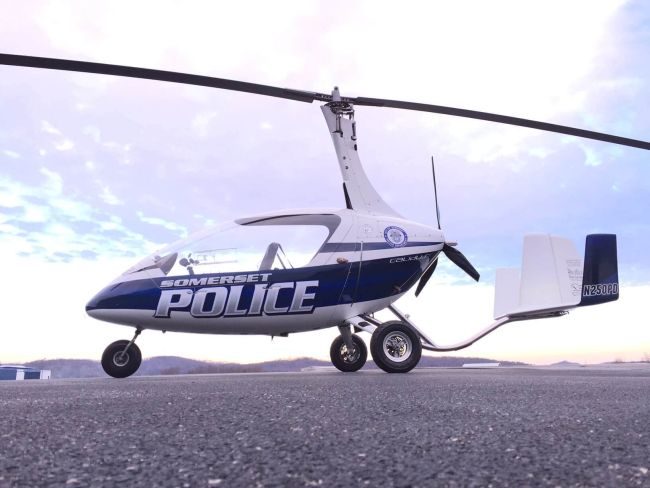What is a Gyroplane?
A gyroplane, also known as a gyrocopter or autogyro, is a relatively simple aircraft concept, and easy to fly – but often historically misunderstood. It is also incredibly safe to fly when flown within its normal flight envelope. Like any aircraft.
So how do they work? Let’s take a simplistic look at other flying machines…
A helicopter flies because an engine spins the main rotor blades (the ones above the aircraft), each of which is a wing, and generates lift, sucking the helicopter body upwards, and into the flight direction required depending on which way the disk is tilted. The little propeller at the back is there to stop the body from turning under the rotor due to the engine torque reaction. Helicopters are fuel-thirsty, a little noisy and complex, and require expensive maintenance. But they can take off, hover, and land vertically.
A ‘fixed wing’ aeroplane uses an engine and propeller to pull or push the wing through the air. As the air passes over the wing, lift is generated and the aircraft flies. Aeroplanes are relatively simple but have a couple of disadvantages. If they fly too slow, the lift generated from the wings can be lost – called a stall – at which point the aeroplane can fall. Also, any landing – with or without the engine running – must always be above stall speed, meaning that a runway or open area is required within which to safely stop.
Gyroplanes bridge the gap between these two technologies, simply and effectively – exactly as Juan de la Cierva intended in the 1920s when he invented the ‘Autogiro’.
The rotating wing above the gyroplane is not powered in flight. Like a fixed-wing aircraft, the engine and propeller pushes – or pulls – the aircraft body through the air, driving air through the rotating wing (or rotor). This airflow forces the wing to rotate, and as it rotates the aerofoil section generates lift. Flying a gyroplane is relatively easy. There is no helicopter collective control needed, and the rotating wing speed is self-regulating. There are no fixed-wing aeroplane flaps or ailerons to manage, they are simply not required.
A gyroplane cannot take off, hover, or land vertically (unless with a driven rotor, see later…). But because the rotating wing speed is NOT engine driven and powered only by oncoming airflow, it will always keep spinning whether the engine is running or not. Even if descending vertically, the air still flows through the wing, making it spin.
The speed of the rotating wing is independent of the gyroplane speed. This is called ‘Autorotation’, hence ‘AutoGyro’. It means that very low-speed landings can be made with little runway needed to stop, fantastic in the event of an engine stoppage in the day – and especially at night.

It also means gyroplanes can operate at very low airspeed; A normal minimum level flight speed can be as low as 25kts / 30mph /40kmh, and a gyroplane can generally be safely operated at 0 indicated airspeed. All because the wing speed is independent of the engine or gyroplane body.
Similarly, gyroplanes can also fly at very high speeds. Most recreational gyroplanes have a maximum speed of around 105kts / 120mph /190 kmh. Drag and fuel burn increases significantly above this, requiring clever wing construction to achieve the 1950s achievements of 175mph.
Key is the resulting gyroplane in-flight stability. The wing is flying very fast, around 350mph at the tips. This means that it is moving very rapidly compared to the gyroplane body, and effectively chopping through turbulence. Gyroplanes – and the occupants – do not suffer in turbulent conditions, and sick bags are not normally required!
Gyroplanes hold a unique place as aerial vehicles. Very safe operating characteristics, low operational costs, excellent fuel range, and providing an operational package that is hard to beat – and phenomenal fun to fly!
So whether you want to fly for fun, or to earn a good living, look at what an AutoGyro gyroplane can offer. You may be very surprised!


Best Quality &
Super-Service
At AutoGyro, we are proud of the smiles that our customers take home, as much as of the gyroplanes themselves.
Handcrafted + Passion + Time
Gyroplanes are unique aircrafts that use a combination of fixed-wing and rotorcraft technology to achieve safe and reliable flight. Hopefully, the article above, and the links provided have given you enough understanding to appreciate these amazing machines.
But knowing how gyroplanes work is only part of the magic of AutoGyro. Rather than computer-generated images and empty promises, AutoGyro delivers reality. We fulfil your aviation dreams with beautifully prepared and finished aircraft, year after year. AutoGyro has over 20 years of real-world experience. And over 3100 real aircraft in service.
We are driven to delight our customers.
-
With multiple onboard safety systems and system redundancies.
-
With proven technologies compliant with international and national standards.
-
By driving for a green footprint with low aircraft noise, low fuel burn and recyclable materials wherever safe and practical.
- By using internationally available major assemblies and components to ensure ease of serving and repair in the field; Rotax engines, Garmin avionics, and Woodcomp propellers for example.
- With a full spare parts and service backup, covering 20 years of manufacturing already.
Do we believe in what we say? Our CEO, Gerry Speich, does. As a gyroplane pilot – and test pilot – for approaching 30 years, he regularly flies AutoGyro aircraft right across Europe, from the UK to Turkey, Africa, and in America. In AutoGyro, we walk the talk.
Gyroplanes give you:
-
Short takeoff and landing capability
-
Low operating costs compared to traditional aircraft
-
Reduced susceptibility to turbulence and wind gusts
-
Unique and exciting flying experience
-
Ability to fly at low altitudes and slow speeds for aerial photography and surveillance
-
High safety record due to autorotation capabilities and stability in flight
-
Versatile applications including agriculture, search and rescue, and surveying
-
Ease of handling and control, with simple and intuitive controls
-
Reduced noise pollution compared to helicopters
-
Ability to operate from almost any flat surface, including water with amphibious models
-
Ease of handling and control, with simple and intuitive controls
-
Low fuel consumption and emissions compared to traditional aircraft




Come by and experience our Gyroplanes.
Looking for an exciting adventure that will leave you with unforgettable memories? Come visit our factory and experience our gyroplanes in person!
At our factory, we produce high-quality gyroplanes that offer a unique and thrilling flying experience. Whether you’re a seasoned pilot or a first-time flyer, our gyroplanes are designed to provide unmatched performance, stability, and maneuverability.
When you visit our factory, you’ll have the opportunity to see our production process up close and meet our team of experienced professionals. We take pride in our attention to detail and our commitment to quality, and we’re confident that you’ll be impressed by our state-of-the-art facilities and cutting-edge technology.
But the real highlight of your visit will be the chance to fly our gyroplanes for yourself. We offer a variety of models to choose from, each with its unique features and capabilities. Whether you’re looking for a recreational flying experience or a commercial application, we have a gyroplane that’s perfect for your needs.
Our experienced pilots will guide you through the basics of gyroplane flying and take you on an unforgettable adventure in the skies. You’ll get a firsthand look at the incredible stability and maneuverability of our aircraft, and you’ll experience the thrill of flying in a way that simply can’t be matched by traditional fixed-wing aircraft.
So what are you waiting for? Come visit our factory and experience the excitement of gyroplane flying for yourself. We’re confident that once you try it, you’ll be hooked on this incredible technology and the amazing experiences it can offer. Contact us today to schedule your visit and get ready for the adventure of a lifetime!

FAQ’s
One advantage of flying a gyroplane is its ability to take off and particularly land in short distances, making it useful for operations in areas with limited space or rough terrain. Gyroplanes cope with turbulence and high winds easily, making them very stable and safe in these conditions. Gyroplanes have a huge speed range, being safe and easy to fly from 0 to maximum speed. Gyroplanes are also relatively inexpensive to operate and maintain, making them a cost-effective option for many applications.
Gyroplanes are simply enormous fun to fly!
Gyroplanes have proven to be versatile aircraft since their invention in 1920, finding various applications such as personal transportation, search and rescue, military reconnaissance, and agricultural operations. They are very popular among hobbyists and sport pilots, who enjoy their unique flying characteristics and maneuverability.
Of course! As we wish to have enough time for all our customers, please make an appointment for a factory tour with our team. You may contact us via mail or telephone, or via your Sales Partner.
Gyroplanes are regarded as one of the safest aircraft on the market. Thanks to the so-called autorotation, we do not need a pyrotechnical parachute. We can navigate safely and operate a controlled landing even in emergency situations.
A gyroplane is similar in appearance to a helicopter, but it differs in several key ways. A gyroplane is capable of forward flight but cannot hover in place like a helicopter, and its rotor does not provide lift during takeoff or landing. Gyroplane controls are simple and intuitive, consisting of a stick for controlling the rotor disc attitude to adjust roll and pitch, and rudder pedals to control yaw. They are easier to fly than a helicopter, and the control systems are easier and far less expensive to maintain.
How does a gyroplane fly ? – A gyroplane flies by using an unpowered rotor in autorotation to generate lift, and an engine-powered propeller to provide forward thrust. As the gyroplane moves through the air, the airflow through the rotor generates lift, allowing the gyroplane to fly.
Yes, we produce the MTOtrigo, a three-seat version of the MTOsport 2017. However most gyroplane markets are currently restricted to two seats only due to the maximum permitted take-off weight, so the use of the three-seat version is limited currently.
AutoGyro is working on a large multi-seat gyroplane product, coming soon… This aircraft is not in the Ultralight class and is intended as a fully certified aircraft.
Yes, and no; the type of pilot licence you have to obtain will depend on the country where you fly. In most countries, you will need to obtain a pilot’s licence specifically for gyroplanes. Currently, there is no internationally recognised gyroplane licence. The requirements for obtaining a gyroplane rating include a minimum number of flight hours and a practical test.
